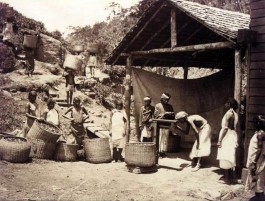History of Darjeeling Tea

The history of Darjeeling Tea is intertwined with the history of Darjeeling built over 150 years from the time of the British Raj. Knowing a brief account of the creation of such a precious treasure facilitates greater understanding and appreciation. The British were the ones who began this hugely profitable industry in the 1800s.
Darjeeling is now the world-renowned producer of aromatic teas. It was the year 1815, when the Raja of Nepal seeded the area of Darjeeling to the East India Company under the ‘Treaty of Titaliya’, but retained certain administrative powers. However, in 1835, this area again came under the direct rule of the East India Company by a Deed of Grant from Raja.
Following the opium war, the British wanted to find an environment similar to the mountainous regions of China where tea was grown as Tea was considered a luxurious item during the reign of the Qing dynasty and fetched high value. The seeds were sourced from China and transported secretly to Darjeeling. Before tea production, Darjeeling was a place used by the British only as a health resort for their Army. In 1834, Lord William Bentinck (the then British Governor-General) commented on the prospect of growing tea-“to consider the question of importing seed and plants from China; to decide upon the most favorable localities for growing them.”
Seeds were bought from China and evenly distributed across plantations. These seeds were raised in government nurseries. Dr. Campbell, a civil surgeon and first superintendent of Darjeeling, transferred from Kathmandu by the government, took the first initiative and planted some of the seeds in his own garden, known as the Beechwood, located at 2,134 meters above sea level in the year 1841. During this time, not more than 25 families lived in this hilly region.
Dr. Campbell’s initiative yielded successful results and established that a climate of Darjeeling was greatly suitable for tea production. Following Dr. Campbell’s results, the government decided to encourage tea production in Darjeeling and even offered land on favorable terms in 1847.
According to the government’s formula, each forest land allotted could only clear 40 per cent of the land to plant tea and the rest would remain unadulterated forest. Captain Samler was the first tea planter who started the Alubari tea garden in 1856 under the management of Kurseong and Darjeeling Tea Company, as reported in the ‘Darjeeling Gazetteer’. This was followed by the Harsing garden and Dooteriah by Dr. Brougham in 1859.
However, Dr. Campbell’s faced a labor shortage for the work required at the tea gardens. He requested Shri Dakman Rai, a Nepalese nobleman to assist him by immigrating and bringing workers from Nepal. Thus Mr. Rai returned to Darjeeling with thousands of immigrants who belonged to the Gorka or Nepalese community. In appreciation for his helpful services, Mr. Rai was given grants of free hold lands.
But this initial group of labors did not suffice the needs of the industry and one of the Directors of the Darjeeling Tea Company, Mr. Christison, requested Mr. Dakman to provide them with more laborers from Nepal. In return, he was promised a supply of tea seeds to establish his own plantation in the lands that he was gifted by Dr. Campbell. With those lands Mr. Rai in 1878 established Soureni, Phuguri in 1880, and Sampripani in 1883. There was a common proverb in Nepali in those days that went, “Chiya ko butta ma paisa fallcha,” meaning tea bushed yield money. Mr. Rai successfully used this proverb to lure immigrants from neighboring countries.
The Darjeeling Tea Company launched Ging, Ambootia, Takdah, and Phoobsering between 1860 and 1864. Lebong Tea Company also started Tukvar and Badamtam gardens during this period. Pandam, Stenthal, Makaibari, and Singell tea gardens also came into existence around that time. By 1866, there were almost 39 Darjeeling tea estates that produced 21,000 kilograms of tea that increased to 56 Darjeeling Tea gardens producing 71,000 kgs by 1870.
Pioneers to accelerate its growth were tea stalwarts such as Mr. Stolke (started Steinthal in 1847), Dr. Grant (established Windsor Tea Estates), Captain Masson (started Tukvar in 1856), Mr. Smith, Captian Samler, Mr. Martin (established the Hopetown Tea Estate), Mr. James White, Mr. George Christison, the Barnes Brothers (started Mineral Springs, Bannockburb and Soom), Mr. David Willson (started Happy Valley), and Mr. Bhagatbir Rai. By 1874, tea business in Darjeeling was found to be a profitable venture with 113 gardens spanning approximately 6,000 hectares thriving, and employing around 19,000 workers.
W. O’Brien Ansell introduced power-driven tea rollers and tea sorting machines. He also laid the foundation for implanting electrical cables and creating connections with Darjeeling tea estates for fast production. Owing to the rise in tea production, employment opportunities increased in this hilly region. People began migrating to Darjeeling to work in tea plantations. Planting, tending, plucking, and manufacturing tea is a laborious job. Slowly, inhabitants increased in Darjeeling and for generations, they have settled there.
With the remarkable growth of the tea industry and population boom, the need was felt to connect the plains and the hell tracts permanently. Thus, Lieutenant Napier started to establish the foundations of the Pankhabari road that still exists today. Later, this road was found to be too steep and narrow for wheeled traffic, and hence in 1861, a new cart road with an easy gradient was built. This cart road then connected with the great road built across Bengal, with Calcutta as the epicenter of business.
With Indian independence, most of the British owners had to dispose of their properties and they were bought by young Indian entrepreneurs. However, for certain British inhabitants-C.W. Emmett and T.J. Hardingham-their love for tea kept them behind in India. By 1960, the Tea Research Association was started to make clones of selected plants to be used for re-plantation.
By 1905 the numbers of these small tea gardens were already 148, covering approximately 18,475 hectares of land and by 1947 the number of estates commercially producing teas was 102 and producing 14 million kilograms of tea per annum. Though some plantations had to be closed down due to economic slump and mismanagement, currently there are more than 85 Darjeeling tea estates producing almost 10 million kilograms of Darjeeling tea annually.
Thus the knowledge of history of Darjeeling Tea makes you appreciate the warm cup of Tea even more knowing that it is a cumulative product of work of many cultures and generations.
Reference: www.blog.darjeelingteaxpress.com/darjeeling-tea-gyaan/history-of-darjeeling-tea

